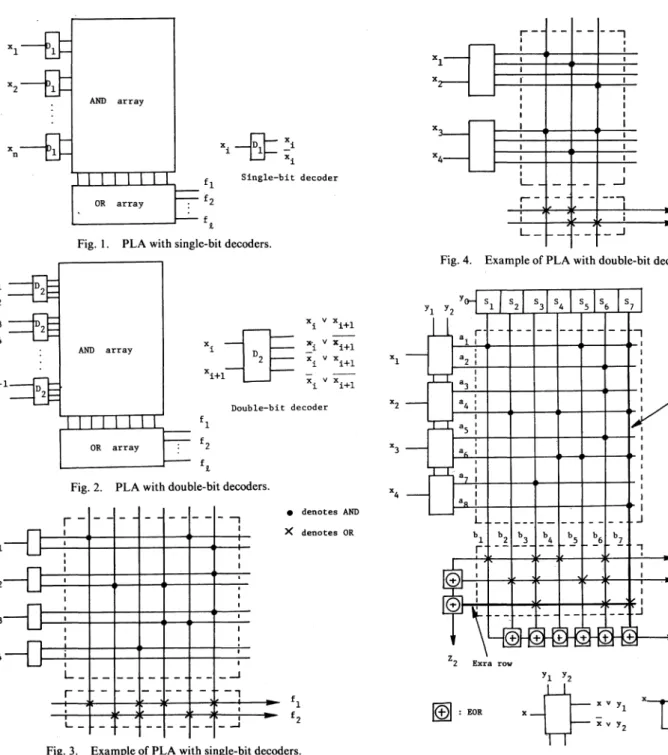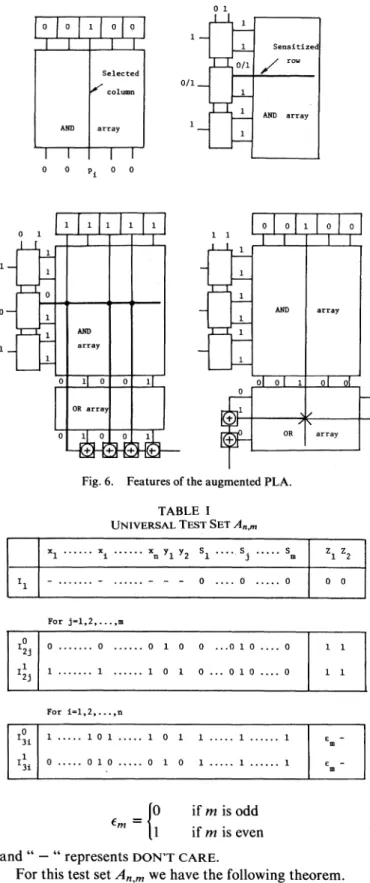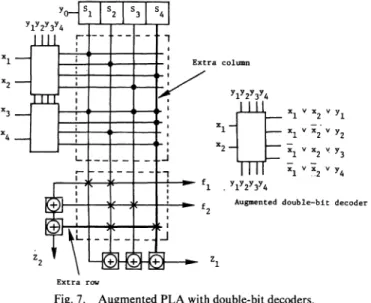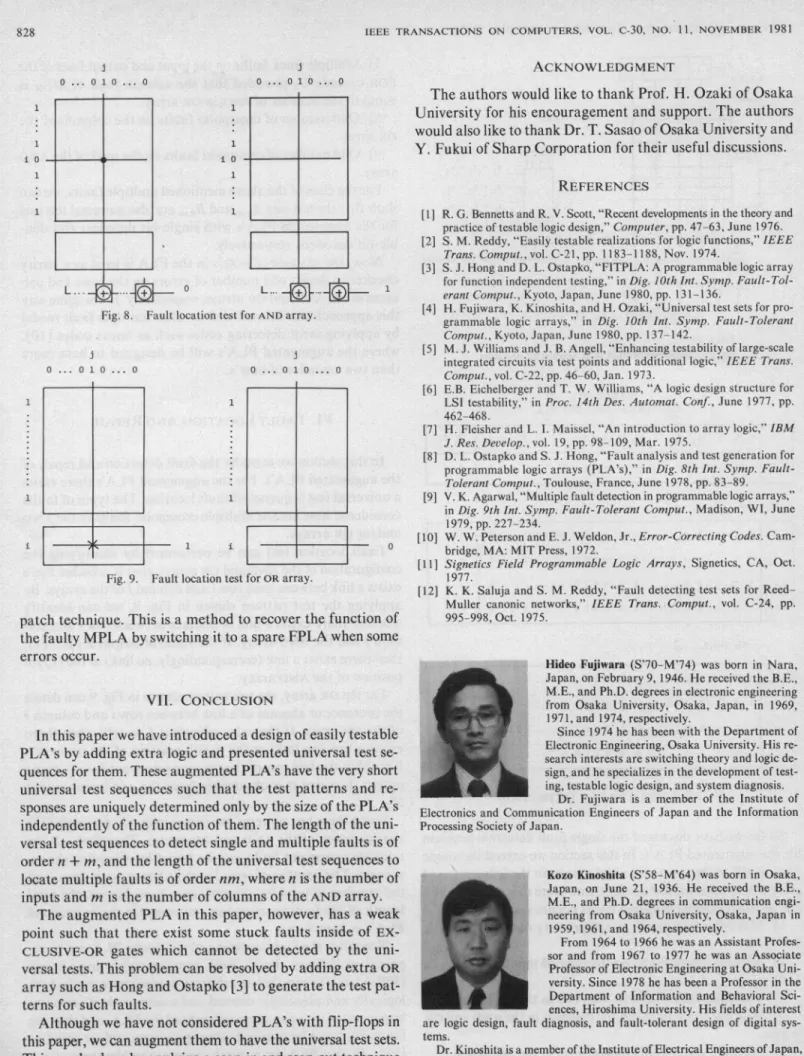A Design of Programmable Logic Arrays with
Universal Tests
HIDEO FUJIWARA, MEMBER, IEEE, ANDKOZO KINOSHITA, MEMBER, IEEE
Abstract-In thispaperthe problem of fault detectionineasily testableprogrammable logicarrays(PLA's) is discussed.Theeasily testablePLA'swill bedesigned by addingextralogic. These augmented PLA'shave thefollowing features: 1) foraPLA with ninputsand m columns(product terms), thereexists a "universal"testset such that the test patternsandresponses do notdependonthefunction of the PLA, but depend onlyon thesizeof the PLA(the valuesn andmi);2) the numberoftests isoforder n + m. For theaugmented PLA's, universaltest sets to detectfaultsinPLA'sarepresented.The types offaults considered here are single and multiple stuck faults and crosspoint faults in PLA's. Fault locationandrepair of PLA'sarealso considered.
IndexTerms-Easily testable design,faultdetection,faultlocation, logic circuits, programmable logic arrays (PLA's), universal test sets.
I. INTRODUCTION
W5jrITH the increasingcircuit densityin a single large- scale integrated (LSI) circuit chip, the difficultyof testingthecircuits is becoming apparent.Inorderto overcome thisproblem, methods have beensuggestedin whichtestpoints andadditional logicareused for the purpose of easing thetest generation problem [1]-[6]. Designingeasilytestablecircuits, one shouldpay attentiontothefollowing features: 1)thecost ofgeneratingtestpatterns islow,thatis,thecomputationtime fortestgeneration isshort;and2)thecostoftestingthe circuits islow, thatis, thelengthoftestsequence is short.
This paper is concerned with theproblemoffault detection and location in theeasilytestableprogrammable logicarrays (PLA's)whichhave the abovementioned features. The PLA, whichis conceptuallyatwo-level AND-OR,isattractive in LSI duetoitsmemory-like arraystructure. Amethod ispresented toaugment PLA'sbyaddingextralogicsothat theaugmented PLA's havethefollowing easily testable features: 1) for a PLA withninputs and m columns (product terms), there exists a
"universal"test setsuch thatthe test patterns and responses donotdependonthe function of the PLA, but depend only on the size of thePLA(the values n and m); 2) the number of tests isof order n + m. Since the augmented PLA's have the uni- versaltestset, the test generationof PLA's is no more neces- sary, and thecostoftestgeneration is considerably reduced toalmostzero.Theaugmented PLA's introduced in this paper aresimilartothePLAwhich wasindependently obtained by
Manuscriptreceived December 10, 1980; revised May 26,1981. H. Fujiwara iswith the Department of Electronic Engineering,Osaka University,Osaka, Japan.
K.Kinoshitais with theDepartmentofInformationand Behavioral Sci- ences,HiroshimaUniversity, Hiroshima,Japan.
Hong and Ostapko [3]. However, since the augmented PLA's considered inthis paper need less additional hardware than [3] and also sincenotestsequence for multiple faults appears in [3], we will present universal test sequence for single and multiple faults in the PLA's. First, single-stuck faults and single crosspoint faults are considered, and the universal test setsto detectthese faultsinPLA's are presented.Then the type of faults are extended to multiple faults. Fault location and repair of PLA's are also considered where the faults are as- sumedtobemultiple crosspoint faults.
II. PROGRAMMABLE LOGIC ARRAYS
Aprogrammable logic array (PLA) consists of three main parts. These are the decoders, the AND, and the OR arrays. The decoders are usually implemented by single-bit decoders or double-bit decoders, as shown in Figs. 1and 2. Both the AND array and the OR array are used to implement multioutput combinational logic with sum-of-products forms. Fig. 3 shows an example ofa 4-input, 2-output PLA withsingle-bit de- coders, which realizes two functionsinthefollowing:
fl = X1 V X4 V X2X3 V X1X2X3
f2= X2 V X4 V XIX3 V X1X2X3.
Fig.4shows another realization using a PLA with double-bit decoders.
Inthefollowing Sections III and IV, we present a method toaugmentPLA's withsingle-bit decodersordouble-bit de- coders byaddingextralogicsothat theaugmented PLA'sare easily testable PLA'swith short "universal" testsequences. The types offaults considered in SectionsIIIandIVaresingle faultsinthePLAwhicharethe stuckfaults and the crosspoint faults. Acrosspoint fault in a PLA is a fault such that the presence (absence) ofacontact between a row and column of thePLAbecomes the absence(presence) of thecontact.
III. AUGMENTED PLA's WITHSINGLE-BIT DECODERS Inorder todesignan easily testablePLA with single-bit decoders, we augmentagiven PLA by adding extra logic, that is,ashiftregister, two cascades of EOR'S (EXCLUSIVE-OR'S), andonecolumnandone rowtoANDandORarrays, respec- tively,asshown in Fig.5.Theconnections of the added column intheANDarray isarrangedsothat eachrowof theANDarray hasanodd number of connections. Similarly, the connections of the addedrowintheORarray isarrangedsothateachcol- umn has an odd number ofconnections. In the augmented 0018-9340/81/1100-0823$00.75 © 1981 IEEE
xl
x2e
n <
AND array
I I I I
1 1 1 1
fl SingleOR array f2
fg
Fig. 1. PLA withsingle-bitdecoders.
x x
x3
xi x4_ e-bit decoder
M-c - - N
II I; ;I f2
Fig. 4. Example of PLA with double-bit decoders.
1
ID2
xi Vxi+
wi xi+l
Xi v xi+l
Xi v xi+l Double-bit decoder
x1
x2
x3
f1
f2
fi,
Fig. 2. PLA withdouble-bitdecoders.
r- 0 denotes AND
X denotes OR
e- - --- - -- .
r - ___ _^~ i2 fl
f,
_4d
_ __-__j
- 2Fig.3. ExampleofPLAwithsingle-bit decoders.
PLAeach column(product term)biis ANDed by each variable
Si
of the shiftregister
asfollows:bi =pi, Si fori= 1,2,*,m
where pi isaproduct term generated by the ith column of the ANDarraywithout the shift register and m is the number of columns.Fig.5shows a PLA augmented from the PLA shown inFig. 3.
Theaugmented PLA has the following properties. 1) The shift register can be used to select an arbitrary col- umnof theANDarrayby setting 1 totheselected column and 0 toall other columns. [See Fig. 6(a).]
2) Theaugmenteddecoders with control inputsy1and Y2 canbeusedtosensitizeanarbitraryrowof theANDarray by setting0or 1 totheselectedrowand1 toallotherrows. [See Fig. 6(b).]
column
$~~~~~~~~~~~~~~~
2 Exra row Y1 2
Yl Y2
: EOR x
Fig.5. Augmented PLA with single-bitdecoders.
3) The cascadeof EOR'sbelowtheORarraycanbeused
as aparitycheckertodetectsingleerrorsinthesensitizedrow
of theAND array. [See Fig. 6(c).]
4) ThecascadeofEOR'Sonthe left of theORarray canbe usedas aparitycheckertodetectsingleerrorsinthesensitized column of theORarray. [See Fig. 6(d).]
Utilizingthe abovepropertiesof theaugmentedPLAwecan
present auniversal test set todetect single faults in the fol- lowing:
1) stuckfaultsontheinputoroutputlinesofgateswithin thedecoders, theANDarray,and theORarray,
2) crosspointfaults in theANDandORarrays.
TableIshows thetest setAn,mtodetectthe abovetypesof faults, wheren is thenumber ofinputs, m is thenumber of columnsintheANDarray, and
X2--
X34{
- -i
r- - .. - - -1
1- I
JT
_x4
-I UCI C VA
I
01
0 0 1
F ~~~~~~~~~~1t
Selected 0/1
0/1
column 1
1
AND array 1
0 0 Pi 0 0
Sensitized D rw
AND array
Fig. 6. Features of the augmented PLA. TABLE I
UNIVERSALTEST SETAn,m
X1 ... * - - nY1 Y2 S1 2m 12 10 ....0 ...0.. o o o
For j=1,2,...,m
|I2j |°.... ... 0 1 0 0 ...O1 0....O 1 1
II2j . . ...101 0...0 1 0....0 1 1
For i=1,2,...,n
I3i0 1 .10.1 ... 1 0 1 1... 1 ... 1 em
| Ii|°... .°10...0 1 ....O1.1 ......1|e-l
I 0 ...0 10 ...010 1. .1
3i In
(Em =I ifm is odd
ifm iseven
and"-" represents DON'T CARE.
For thistestsetAn,mwehave thefollowingtheorem. Theorem 1: LetMn,mbeanaugmentedPLAwith single-bit decoders which hasninputsandmcolumnsintheANDarray.
ForanyMn,mthetestsetAn,mcandetect allsingle stuckand crosspoint faults in thedecoders,andANDarrayand theOR array.
Proof: Whenwe apply test inputs
Io
and , the jth column isset toIandother columnsareallset to0.Therefore,bothI° andI candetectanycrosspointfaultonthejthcol-
umn of the OR array by observing the output Z2, and a
stuck-at-O fault on thejthcolumn, stuck-at-I faultsonthe other columns, and stuck-at-O faultsontherowsoftheAND arrayby observingtheoutput
ZI.
Anystuck faultontherow oftheORarraycanbedetected bysomeIo
and I2; (1 <j < m).Byapplying testI°i (I3i),the (2i - I)th (2ith) row of the ANDarrayisset to0and otherrows areallset to1.Therefore, testI3i(13)candetect all crosspoint faults and astuck-at-1 faultonthe2i- 1th (2ith)rowin theAND arraybyobserving theoutputZ1.Tests I°%,I;
(j
= 1,2,"*, m)andIo,
I3i (i=1,
2,**, n) can alsodetect all stuck faults in the decoders. The stuck-at-O faults ontheinputlines ofORgates canbe detected by1o
andIP
j= 1, 2, ,m).The stuck-at-I faultsontheinput lines ofOR gates can be detected by I3i and
Ili
(i = 1, 2,, n). The stuck-at-O faultsontheinput lines xi (i = 1,2, *, n),Yl,and Y2canbedetectedby
I° andI2(j
= 1,2,-,m).
The stuck- at-I faultsontheinput lines xi (i= 1,2, * ,n),y1,andY2can be detected byIo
andI3i(i = 1, 2, **, n). Q.E.D. Next,wewill show that thetest setAn,mcanalso detect any multiple stuck fault in the EXCLUSIVE-OR cascadesunderthe fault assumption that permits only stuck-type faults onthe externalinput andoutputlines ofEORgates, thatis,nofault withinEORgatesis considered.We have the following lemma. Similar results appearin [12].
Lemma1: For anEXCLUSIVE-OR cascade realizationof ak-input linear function, all multiplestuckfaultson the ex- ternallines ofEOR gates can bedetected bythefollowingk +
1 tests:
to =(°,0,* )
t= (1, 0,.., 0) t2=(0,1 ol ...IO)
*1\
tk =(O,O, ,lO,1.
Proof:-
Any
linear function of k orfewer variablescan beexpressed in the formIA(XI,x2,**,Xk) =aO CD3aix, (1Da2X2 CD3..**( akXk whereai =Oor I fori = 1,2, *k andA =
(ao,al,,a2,
ak).-
Itcan easilybeshown thatevenifone or morestuck-at-0 orstuck-at-I faults areintroduced into the EXCLUSIVE-OR
cascade,theresultingcircuitstill realizesa linear function.
Sol
any faulty function of the EXCLUSIVE-OR cascade can be expressedinthe above form. WhenA =(O, 1, *,1),thelinear functionIA represents the fault-free linear functionlk.LetIB =boEDbXxi(1ED-- a
bkXk'
bealinear function real- izedbyacircuit undertestwherebi = OorI fori = 1,2,-**, k.Applyingthevectorsto,t1, ", tk tothe equationlA(X1,X2,' .,Xk) = lB(X1,X2, , Xk)
weobtain
ao= bo
aO@a, = boCD bi
ao@ ak = boCD bk
which implies
ai =bi fori =0, 1, 2,*,k.
Therefore,we canuniquely determine the valuesai's,and thus distinguishwhetherIB equalstothe fault-free linearfunction
ornot. Q.E.D.
In Lemma 1 k+ 1teststo, t1, tkcan easily be extended
tok linearly independent vectorsplus zerovector.Then we
havethefollowing lemma.
Lemma 2: If kinputvectorsarelinearlyindependent,then these k vectors pluszero vector aresufficient todetect any
multiple stuck faultonthe external lines ofEOR gatesin a
k-inputEXCLUSIVE-ORcascade.
LetMn,mbeanaugmentedPLA,andletC1 and C2be the cascadesof EOR'shavingtheoutputZ1andZ2, respectively, inthe augmentedPLAshown in Fig. 5.Let MOR=
[a11j]
bea matrix ofI rowsandm columns where
aij=
O
ifthere existsalinkatthe(i,j)thposition of theORarray,and
otherwise.
ByLemmas 1and 2wehave thefollowingtheorem for the multiplefaults intwocascades ofEOR'S, C1 andC2.
Theorem2: ThetestsI1,
Io (j
= 1, 2,* ,m)in An,m aresufficienttodetect allmultiplestuck faults inC1. If thecolumn rank ofmatrixMORis equaltothe number ofinputs of the
EXCLUSIVE-OR cascade C2, then all the multiple stuck faults inC2canbedetected bytestsII,and
Io
(j = 1,2,**, m) inAn,m.Note that if the column rank of matrixMORisnotequalto the number ofinputsofthe cascadeC2 althoughithardlyoc-
curs,then it isnotguaranteedthat allmultiplestuck faults in the cascadeC2canbe detectedbythetestsmentioned above. Toovercomethisproblem,itmightbenecessarytoaddextra ORarraysothat the rank of MOR isequaltothe number of inputsof theEXCLUSIVE-OR cascade C2.Note also thatwe permit only stuck-typefaultsontheexternalinputandoutput lines ofEORgates. However,by addingextraarrayit ispos-
sibletogeneratealltest patternsfor thecascade C1 andC2. Thistechniquewasreportedby HongandOstapko [3].
Usingthetest setAn,m,wecanconstructatestsequencefor theaugmentedPLA'sasfollows:
an,m =III21 I22.*.*I21mI22"1*. I2m
U1U2 Um-I I31I32 I3nI31 I12 31n where thetestpattern Ui (i= 1, 2,-* ,m - 1) isdefinedas
XI1 **XnYiY2SIS2..*SiSi+I...SmZiZ2
Thetestsequencean,mcanalso detect the shiftfunction of
the shift register,aswellasallsingle stuck and crosspoint faults inthe PLA. The length of the test sequence is 2n + 3m.
Now wehavepresentedthe test setand thetestsequencefor theaugmented PLA's.Both the test setAn,mand the test se- quencean,mhave thefollowing advantagesofeasytestability. Thetest set An,m does not depend on the connection pattern of thePLA,butdependsonlyonthe valuesnand m,thatis, the test patterns and responsesareuniquely determined only bythe sizeofthePLA.Therefore, thetest set An,m is "uni- versal." We can also see that the testsequence an,rm is uni- versal. Hence, the test generationof the augmented PLA's is notmore necessary. Moreover, the universal test sequence is averyshorttestsequence whoselength is2n +3m.Inthis way we can seethat theaugmented PLA's are very easily testable PLA's having a universal test sequence.
IV. AUGMENTED PLA'sWITH DOUBLE-BIT DECODERS The PLA's with double-bit decoderscan besimilarly aug- mented by adding extra logic, that is, a shift register, two cascades of EOR's, andonecolumn andone row tothe AND andORarrays,respectively, asshownin Fig.7. Fig.7shows a PLAaugmented from thePLAshown in Fig.4.The aug- mented double-bit decoders have four control inputsY1,Y2, Y3, andy4,as shown inFig.7.
For theaugmentedPLAwithdouble-bitdecoders,we can similarlyconstruct auniversaltestsetBn,m,asshown in Table II, and thefollowing theorem holds.
Theorem 3: LetNn,mbe anaugmentedPLAwithdouble- bitdecoders which has ninputs and m columns in theAND array.ForanyNn,m, thetest setBn,mcandetect allsinglestuck and crosspoint faults in thedecoders,theANDarray, and the ORarray.
Theorem4: Bn,r candetect all multiplestuckfaults in the cascade C1. If the column rank of MOR isequaltothenumber ofrowsintheORarray, then allmultiplestuckfaults in the cascade C2canalsobedetected by
Bn,rn.
Usingthetest setBn,m,wecan constructthe universaltest sequence1n,mfor theaugmented PLA'sasfollows:
On, =III21 I22...I'2m I21 I22*2r 121222*2m 21 '22 '2m U1U2 Um-1 I31 I32...I32
3132 I32I3 I32 I3r3 I32 I32
where thetestpattern Ui (i = 1, 2, , m - 1) isdefined as
X1..
*XnY1Y2.Y3Y4
S1..*Si
Si+I ..*Sm
ZIZ2Ui=-*---1 1 1 1 1... I0...0 -
Thelengthof thetestsequenceis 2n+ 5m.
Notethatwealsostatemoregeneralresults for PLA with k-bit decoders. The universal test sequence might be con- structedasfollows:
121 * 2mI21 * * 2 ...I2I2m
Ul U2... Um- J 1 ...In/kI31 I3nk...I31 wr 3nok
where, n2'nd I3'nre. the.teszt patterns fork-bhit deconders extended from 2-bit decoders. The totaltestlength is(2k+
1)m+ (n/k)2k.
I1 111' l l X1 V X2V1
_ L.--~ ~ ~ ~ X X2 _ =xl vx2 v y3
. Augmented double-bit decoder
2~~~~~~~~1
Extra row
Fig. 7. AugmentedPLA withdouble-bit decoders.
TABLE II UNIVERSAL TEST SET Bn,m
1x2 ' X2i-1x2i ... xn-Ixn ylY2Y3Y4 S1 S Sm Z1 Z2
--.01 ... O.. o 0
For j=1,2,...,m
I2j ....O 000... 0 0 1 0 00 0.... 1....O 1 1
I301.1 ... 1 0 00...O 1 1
I2j 1O....1.. 1000100....1... 1 1
For i=1,2,..*'
IO0 . .31 1 1 .... 0 0...1 1 0 1 1 1 1 ......1......1 Emm
I31i .1 0 .... 0 1... O110 1 0 1 1 1 ......1......1 Em
I2 0 0 .. O1 111...1 c0
31 m
I31 m ..1 1... 0 1110 1..
3i
V. MULTIPLE FAULT DETECTION
So farwehave discussed thesinglefault detectionproblem fortheaugmentedPLA's.Inthissectionweextend thesingle fault modeltothetypes ofmultiplefaults in thefollowing,and presentthe universaltest setfor them. Note thatno morethan
oneof thefollowing multiplefaultsoccurssimultaneously. 1) Multiplestuck faultsontheprimaryoutputsxi(i = 1, 2,* *-,n).
2) Multiplestuck faultsonthe controlinputsyi (i = 1, 2, 3,4).
3) Multiple stuckfaultson therowsintheANDarray.
4) Multiplestuck faultsonthe columnsin theANDandOR arrays.
5) Multiplestuck faultsontherowsintheORarray.
6) Multiplestuckfaultsontheinputandoutputlines of the EORcascade C1.
7) Multiple stuck faultsontheinputandoutput linesofthe EOR cascade C2 provided that the column rank ofMOR is equaltothe number ofrowsinOR array.
8) Odd number of crosspoint faultsonthe columns of the ORarray.
9) Odd number of crosspoint faultsontherowsof theAND array.
Fortheclass of the above mentioned multiple faults,we can showthat thetestsetsAn,m and Bn,marealsouniversaltestsets for the augmented PLA's with single-bit decoders and dou- ble-bit decoders, respectively.
Now,the cascade of EOR'S in thePLA isusedas aparity checkertodetect odd number oferrors on therows andcol- umnsof theANDandORarrays,respectively. Inthe same way this approachcanbe extended toother-multiple fault model by applyingerrordetecting codes suchas linear codes [101, where the augmented PLA's will be designed to have more thantwocascades of EOR'S.
VI. FAULT LOCATION AND REPAIR
Inthis sectionweconsider the fault detection and repair of theaugmented PLA's. FortheaugmentedPLA'sthere exists auniversal test sequenceoffault location.Thetypes of faults considered herearethe multiple crosspoint faults in theAND and/orOR arrays.
Fault location test can be performed by identifying the configuration of the AND and OR arrays, that is, whether there existsalinkbetween eachrowiandcolumnjof the arrays. By applying the test pattern shown in Fig. 8, we can identify whether there exists a link or contact between row i and col- umnjandtheANDarray. Ifthe value of output Z1 is 0 (1), thenthereexists a link(correspondingly,nolink)atthe(ij)th position of theANDarray.
Forthe ORarray,thetest pattern shown in Fig. 9 can detect thepresenceorabsence ofalinkbetween row i and columnj ofthe ORarray. If the value of outputfi is 1(0), then there exists a link(no link) at the(ij)thposition of theOR array. Notethat the lastrowoftheORarraydoesnothave a direct output, however it is observable from the additional output Z2.Usingthese testpatterns,we cancompletely determinethe configurationoftheANDand ORarrays.Therefore, all the multiple crosspoint faultscan befoundby observing there- sponses. The number oftestsfor theANDarray is 2nm, and thenumber oftestsfor the ORarray ism. Hence, the total length of the fault location testsequence for theaugmented PLA's is 2nm + m.
Nowafter the fault locationtestthefaultyPLA canbere- paired as follows. For a field programmable logic array (FPLA),it is knownthatanarbitrary product termcanbeboth logicallyandphysically deleted anda newproduct term can begenerated byusingspare columns of thePLA, and thusthe faultyPLA canberepaired usingsparerowsand/orcolumns [11]. If the PLA is a mask programmable logic array (MPLA),it isdifficulttorepairthePLAfor itself. Inthiscase we canrepairthefaultyPLAbyusingthewell-known memory
x1
x2
x3 x4
o... o1o ... o
EL z
1
I 1 0 1 1
0
o... o1o...o
-1-
Fig. 8. Fault location test for AND array.
J o ... o1o ...0
I
Fi Fig.9.
1
I
-1 i I
Fault locationtestforORarray.
0
patch technique. This isamethodtorecoverthefunctionof the faulty MPLA by switching ittoaspareFPLAwhensome
errors occur.
VII. CONCLUSION
Inthispaper wehave introducedadesign of easily testable PLA's by addingextralogic and presented universaltestse- quencesforthem. These augmented PLA's have theveryshort universal test sequences such that the testpatterns and re-
sponses areuniquely determined only by the size of the PLA's independently of the function of them. The length of the uni- versaltestsequencestodetect single and multiple faults is of ordern+m,andthelength of the universaltestsequencesto
locate multiple faults is of ordernm,wherenis the number of inputs andmis the number of columns of theANDarray.
Theaugmented PLA in this paper,however, has aweak point such that there exist some stuck faults inside ofEX-
CLUSIVE-OR gates which cannot be detected by the uni- versaltests.This problemcanberesolved by addingextraOR arraysuchasHong and Ostapko [3]togeneratethetestpat- ternsfor such faults.
Althoughwehavenotconsidered PLA's with flip-flops in thispaper,we canaugment themtohave theuniversaltest sets. Thiscanbedone by applyingascan-inandscan-outtechnique suchasLSSD [51, [6].
ACKNOWLEDGMENT
Theauthorswouldlike to thankProf. H.Ozaki of Osaka University forhisencouragement andsupport. The authors wouldalso like to thank Dr. T. SasaoofOsakaUniversity and Y.Fukui of SharpCorporationfor their useful discussions.
REFERENCES
[1] R.G.BennettsandR.V. Scott, "Recentdevelopmentsinthetheoryand practice oftestablelogicdesign," Computer, pp. 47-63, June 1976. [2] S. M.Reddy,"Easilytestable realizationsfor logicfunctions,"IEEE
Trans.Comput., vol.C-21,pp. 1183-1188, Nov. 1974.
[3] S. J.HongandD. L.Ostapko,"FITPLA:Aprogrammablelogic array for function independenttesting," in Dig. 10thInt. Symp. Fault-Tol- erantComput., Kyoto,Japan, June 1980, pp. 131-136.
[4] H.Fujiwara, K.Kinoshita,and H.Ozaki,"Universal test setsforpro- grammable logic arrays," in Dig. 10th Int. Symp. Fault-Tolerant Comput.,Kyoto, Japan, June 1980, pp. 137-142.
[5] M. J.Williamsand J. B. Angell,"Enhancingtestabilityoflarge-scale integratedcircuits via test points andadditionallogic," IEEE Trans. Comput.,vol. C-22, pp. 46-60, Jan. 1973.
[6] E.B.EichelbergerandT.W.Williams,"Alogicdesign structurefor LSItestability," in Proc.14th Des. Automat. Conf.,June 1977, pp. 462-468.
[7] H.Fleisher andL.I.Maissel, "An introduction to array logic," IBM J. Res. Develop., vol. 19, pp. 98-109, Mar. 1975.
[8] D.L.Ostapkoand S.J.Hong,"Faultanalysisandtest generationfor programmable logic arrays(PLA's)," inDig.8thInt.Symp. Fault- Tolerant Comput., Toulouse, France, June 1978, pp. 83-89. [9] V. K. Agarwal, "Multiple fault detection inprogrammablelogic arrays,"
inDig. 9thInt. Symp.Fault-Tolerant Comput.,Madison,WI, June 1979, pp. 227-234.
[10] W. W. Peterson and E. J.Weldon,Jr., Error-CorrectingCodes. Cam- bridge,MA: MITPress,1972.
[11] Signetics FieldProgrammable Logic Arrays, Signetics, CA, Oct. 1977.
[12] K. K. SalujaandS. M.Reddy, "Faultdetectingtest setsfor Reed- Muller canonic networks," IEEE Trans. Comput., vol. C-24, pp. 995-998,Oct.1975.
Hideo Fujiwara (S'70-M'74) was born inNara,
Japan,onFebruary9, 1946.Hereceivedthe B.E., M.E.,and Ph.D. degreesin electronic engineering from Osaka University, Osaka, Japan, in 1969,
1971,and 1974,respectively.
Since 1974 he has been with theDepartmentof Electronic Engineering, Osaka University. Hisre- search interestsareswitching theory and logic de- sign, and he specializes in the development oftest- ing, testable logic design, andsystemdiagnosis.
Dr. Fujiwara is a member of the Institute of Electronics and Communication Engineers ofJapanandtheInformation Processing Society ofJapan.
KozoKinoshita (S'58-M'64) wasborn in Osaka,
Japan, on June 21, 1936. He received the B.E.,
M.E.,and Ph.D.degreesincommunication engi- neering fromOsaka University, Osaka,Japan in 1959, 1961, and 1964, respectively.
From1964to1966 hewas anAssistant Profes-
sorandfrom 1967to 1977 hewas anAssociate Professor of ElectronicEngineeringatOsakaUni- versity. Since1978 he has beenaProfessorin the Department ofInformation and Behavioral Sci-
ences,Hiroshima University.Hisfieldsof interest
arelogic design, fault diagnosis, and fault-tolerant design of digitalsys- tems.
Dr.Kinoshita isamemberofthe Institute of Electrical Engineers ofJapan, theInstitute of Electronics andCommunicationEngineers ofJapan,and the Information Processing Society ofJapan.
I
1
±0 1 1
1
1
i
J
j



